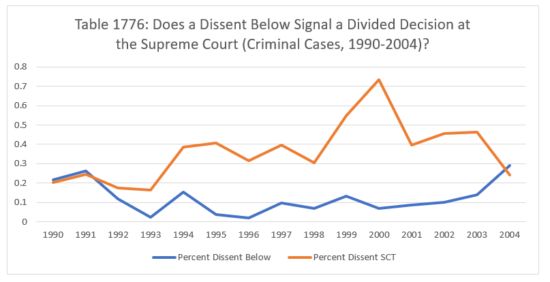We determined last time that there was relatively little connection between the rate of dissent at the Appellate Court and the likelihood of division at the Supreme Court in civil cases. This time, we're looking at criminal cases for the same years: 1990 through 2004.
The connection between dissent at the Appellate Court and Supreme Court was even weaker in criminal cases. The rate of dissent at the Appellate Court was higher than division at the Supreme Court in only three of the fifteen years between 1990 and 2004: 1990-1991 and 2004. On the other hand, in 1993, only 2.33% of criminal cases had a dissent below, while 16.28% had a divided vote at the Supreme Court. The following year, the margin was 15.38% in Appellate Court dissent, 38.46% division at the Supreme Court. In 1995, only 3.8% of cases had a dissent at the Appellate Court, while 40.51% had dissenters at the Supreme Court. The following year, 1.9% of criminal cases had a dissent below, while 31.48% had a dissent at the Supreme Court. In 1997, 9.5% at the Appellate Court to 39.68% at the Supreme Court. In 1998, 6.9% at the Appellate Court to 30.56% at the Supreme Court. The following year, 13.21% of criminal cases had a dissent below to 54.72% at the Supreme Court. In 2000, only 6.98% of criminal cases had a dissent below, while 73.26% had a dissent at the Supreme Court. In 2001, 8.6% at the Appellate Court, 39.66% at the Supreme Court. In 2002, 10% at the Appellate Court, 45.71% at the Supreme Court. In 2003, 13.85% at the Appellate Court, 46.15% at the Supreme Court.

Join us back here next week as we address the data for the years 2005 through 2020.
Image courtesy of Flickr by Gary Todd (no changes).
The content of this article is intended to provide a general guide to the subject matter. Specialist advice should be sought about your specific circumstances.

